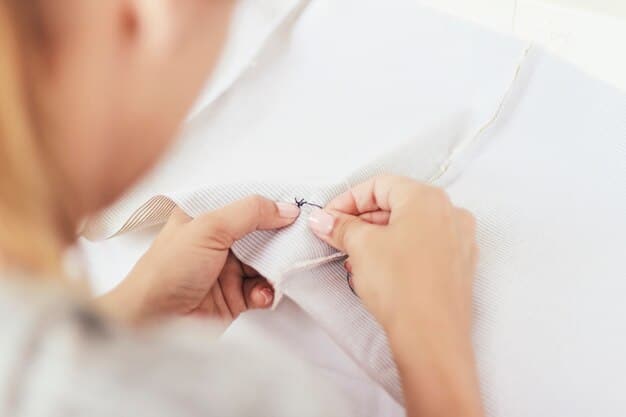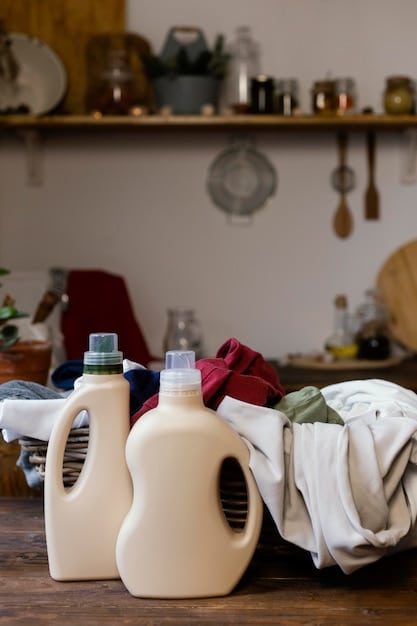Shop Smart: Avoid Budget Fashion Mistakes That Cost You Money

Shopping smart means avoiding common budget fashion mistakes that can actually cost you more money in the long run, such as buying low-quality items, failing to consider cost per wear, and neglecting proper garment care.
Want to look stylish without breaking the bank? It’s possible! However, many shoppers fall into traps that seem budget-friendly but end up costing more. Learning to shop smart: avoid these common budget fashion mistakes that cost you money is key to building a wardrobe you love, without regrets.
The Allure of “Cheap” and Why It Fails
The siren song of deeply discounted clothing can be hard to resist. However, focusing solely on the price tag is often the first step down a path paved with buyer’s remorse. Understanding why “cheap” can be deceptively expensive is crucial to smart budgeting.
The Quality Conundrum
Lower prices often come with lower quality. This means flimsy fabrics, poor construction, and a shorter lifespan for your garments.
The Psychology of Sales
Retailers use sales and discounts to create a sense of urgency, leading to impulse purchases. Ask yourself: would you buy this item at full price? If the answer is no, walk away.
Instead of chasing rock-bottom prices, prioritize items made from more durable materials. Consider fabrics like cotton, linen, wool, or blends that hold their shape and withstand regular wear and washing. Additionally, examine the construction: are the seams straight and secure? Are the buttons or zippers firmly attached? Paying a little more upfront for quality will save you money in the long run by reducing the need for frequent replacements.
- Invest in durable fabrics like cotton, linen, and wool.
- Check for straight, secure seams and well-attached hardware.
- Avoid overly trendy pieces that will quickly go out of style.
Focusing on classic cuts and neutral colors will ensure your wardrobe remains relevant for years to come. It’s better to have a few well-made, timeless pieces than a closet overflowing with fast-fashion items that you’ll quickly tire of.
Ignoring Cost Per Wear
Cost per wear (CPW) is a simple but powerful concept. It’s the price of an item divided by the number of times you expect to wear it. Understanding CPW can drastically change how you evaluate potential purchases.
Calculating CPW
To calculate CPW, estimate how many times you’ll wear an item. A $10 t-shirt you wear 5 times has a CPW of $2. A $50 dress you wear 25 times has a CPW of $2 as well. See how that works?
The Long-Term View
Applying CPW helps you shift your mindset from focusing on the initial price to considering the long-term value. A more expensive, higher-quality item with a lower CPW is ultimately the smarter choice.

Consider a basic black blazer. A cheap version might cost $30, but the fabric might pill after a few wears, and the lining could tear easily. You might only wear it 10 times before it looks worn out, giving you a CPW of $3. A higher-quality blazer might cost $100, but it will likely last for years and can be worn in countless ways. If you wear it 50 times a year for 3 years, that’s 150 wears, resulting in a CPW of less than $1. By looking at CPW you can see where best your money is spent.
- Calculate the cost per wear for every potential purchase.
- Consider how often you’ll realistically wear the item.
- Factor in the item’s lifespan and durability.
By prioritizing items with a low CPW, you’ll build a wardrobe of versatile, long-lasting pieces that offer real value for your money.
Falling for Trends Instead of Classics
Trends come and go, often at lightning speed. Investing heavily in trendy pieces can be a costly mistake, leaving you with a closet full of clothes you no longer want to wear.
The Fleeting Nature of Fashion
What’s “in” today is often “out” tomorrow. Chasing every trend is a recipe for financial strain and a wardrobe lacking in timeless appeal.
Building a Foundation of Classics
Focus on building a wardrobe around classic pieces that transcend trends. These are the building blocks of a stylish and versatile wardrobe.
Think of a well-fitting pair of dark wash jeans, a classic white shirt, a simple black dress, and a neutral-colored sweater. These items can be mixed and matched in endless combinations and dressed up or down for various occasions. They also serve as a blank canvas for incorporating trendy accessories in a more measured and cost-effective way.
Imagine you spend $200 on several trendy tops that are only in style for one season. The next year, you’ll need to replace them with new trendy tops, costing you another $200. In contrast, if you invest $200 in a high-quality classic trench coat, you can wear it for years to come. You can also introduce trendy elements through accessories, only allocating a set amount per season on accessories.
- Prioritize classic pieces over fleeting trends.
- Choose versatile items that can be styled in multiple ways.
- Incorporate trends through accessories rather than clothing.
By focusing on timeless pieces, you’ll create a wardrobe that remains stylish and relevant for years to come, saving you money and minimizing waste.
Neglecting Proper Garment Care
Proper garment care is essential for extending the life of your clothes. Neglecting this aspect of wardrobe maintenance can lead to premature wear and tear, ultimately costing you money.
The Importance of Reading Labels
Care labels provide crucial information on how to properly wash, dry, and iron your garments. Ignoring these instructions can lead to shrinkage, fading, and damage.
Investing in Proper Tools
Having the right tools, such as garment bags, suitable hangers, and the correct detergents, can make a big difference in preserving the quality of your clothes.
For example, hanging delicate blouses on flimsy wire hangers can cause them to lose their shape. Using padded hangers will help maintain their form and prevent shoulder bumps. Similarly, storing out-of-season clothing in breathable garment bags will protect them from dust, moths, and mildew. Using the right detergent is equally important, as harsh chemicals can damage certain fabrics and cause colors to fade. Using a gentle detergent can increase their longevity.

- Always read and follow care label instructions.
- Invest in high-quality hangers and garment bags.
- Use appropriate detergents for different fabrics.
By taking the time to care for your clothes properly, you’ll extend their lifespan and avoid the need for frequent replacements, saving you money in the long run.
Not Considering Fit and Alterations
Buying clothes that don’t fit properly is another common budget fashion mistake. Even the most stylish and well-made garments will look unflattering if they don’t fit your body correctly.
The Importance of a Good Fit
Clothes that fit well accentuate your best features and create a polished and put-together look. Ill-fitting clothes, on the other hand, can make you look frumpy and disproportionate.
The Power of Alterations
Alterations are a relatively inexpensive way to customize your clothes and ensure a perfect fit. Taking a garment to a tailor can transform it from “okay” to “amazing.”
Imagine you find a beautiful dress on sale, but it’s a size too big. Instead of passing it up, consider having it altered. A tailor can take in the sides, adjust the hemline, or even reshape the garment to flatter your figure. The cost of alterations is often far less than the cost of buying a brand new dress that fits perfectly off the rack.
Alternatively, you might find a pair of pants that fit well in the waist but are too long. Hemming them to the correct length will instantly elevate your look and make the pants more versatile. Another example could include tapering a jacket that you got off the rack, creating a much more custom fit.
- Prioritize fit over price when shopping for clothes.
- Consider the cost of alterations when evaluating a potential purchase.
- Find a good tailor and build a relationship with them.
By paying attention to fit and investing in alterations, you’ll create a wardrobe of clothes that flatter your figure and make you feel confident, leading to fewer unworn items gathering dust in your closet.
Impulse Buying and Lack of Planning
Impulse buying is a common pitfall for budget-conscious shoppers. Without a clear plan or a well-defined sense of your personal style, it’s easy to get caught up in the excitement of sales and discounts.
The Dangers of Impulse Buys
Impulse buys are often driven by emotions rather than needs. These purchases tend to be poorly considered and often end up being regretted.
Creating a Wardrobe Plan
Developing a wardrobe plan is essential for making smart and intentional purchasing decisions. This involves assessing your current wardrobe, identifying gaps, and creating a list of items you need to fill those gaps.
Before heading to the store, take inventory of what you already own. What are your go-to pieces? What items are missing? What colors and styles do you gravitate towards? Once you have a clear understanding of your wardrobe needs, create a shopping list. Stick to this list when you’re out shopping, and avoid getting sidetracked by tempting sales and discounts on items you don’t need.
- Avoid impulse buys by creating a shopping list and sticking to it.
- Assess your current wardrobe and identify any gaps.
- Develop a clear sense of your personal style.
By planning your purchases, you’ll make more intentional decisions, avoid unnecessary spending, and build a wardrobe that truly reflects your style and needs.
| Key Point | Brief Description |
|---|---|
| 💰 Quality Over Price | Cheaper isn’t always better; higher quality items last longer. |
| 👚 Cost Per Wear | Calculate how often you’ll wear an item to assess its true value. |
| ✨ Care Matters | Proper garment care extends clothing life and saves money. |
| 👗 Fit Is Key | Alterations make clothes look better and ensure a flattering fit. |
Frequently Asked Questions
▼
Check the fabric composition, seam construction, and hardware. Durable fabrics, straight seams, and well-attached buttons indicate higher quality. Look for labels that list high quality fabrics.
▼
Hand washing delicates or using a gentle cycle on your machine is recommended. Use a mild detergent and always air dry to prevent damage. You should also store delicate pieces in garment bags.
▼
Yes! Alterations can significantly improve the fit and appearance of clothing, making even budget-friendly items look more expensive and custom-made. You will be surprised at how much better you feel in clothes that fit well.
▼
Create a shopping list before you go and stick to it. Ask yourself if you really need the item and whether it fits into your existing wardrobe. Avoid shopping when you’re feeling emotional.
▼
A well-fitting pair of jeans, a classic white shirt, a black dress, a trench coat, and neutral-colored sweaters are all versatile pieces that can be mixed and matched to create a variety of outfits. They can serve as the base for any trends you want to add.
Conclusion
By avoiding these common budget fashion mistakes, you can build a stylish and sustainable wardrobe without breaking the bank. Remember to prioritize quality over quantity, calculate cost per wear, embrace classic styles, and take good care of your clothes! By making informed choices, you can avoid the pitfalls of fast fashion and create a wardrobe that you will value for years to come.





